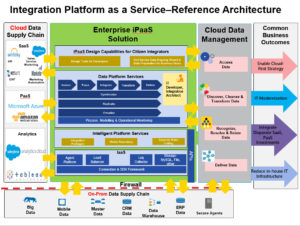Designing Your Cloud Roadmap: Reference Architectures and Architectural Planning

My last post took a closer look at the IT roadmap. For a cloud migration, a transformation around data analytics, or any long-term IT revolution, you create a roadmap to guide you from your present state to the desired future vision. But that begs a question: How do you know what that future vision should look like?
Say you’re mapping a move to the cloud from a mostly on-premises legacy. What does the best version of “going to the cloud” look like, specifically? And how do you make sure that everything on this cloud roadmap works with your larger IT infrastructure?
You can find an answer to the first question with reference architectures, and the second with architectural planning. Let’s look at both.
Leveraging reference architectures
You have to translate your abstracted, executive-level vision and strategy into concrete goals and plans. Reference architectures provide thoroughly conceived examples of what a desired end-state will look like. They’re generic — never perfect for your industry, your business situation, your needs — but they provide a great starting point, which you’ll customize to overcome your specific challenges.
Finding and selecting a reference architecture can be tricky. Industry groups or IT associations may provide them, though they’re not always up-to-date. Analyst firms sometimes have them, though usually at too high a level for roadmapping. Vendors are often the best source, in that vendors have the incentive to create and regularly update their reference architectures. But they can be the worst source, in that they tend to actually be product architectures disguised as reference architectures, and they only frame challenges around the solution the vendor sells.
As you consult with vendors, avoid inherent lock-in. I recommend starting by identifying the capabilities you need. Then identify solutions that can deliver that functionality. You’ll have a better conversation if you lead with, “Tell me how you can help me achieve my goals,” rather than “Show me what you think I should buy.”
Determine which vendor(s) can deliver the most comprehensive set of necessary capabilities. You can then weigh advantages of going best-of-breed vs. all-in with one solution provider.
Overall architectural issues
While the reference architecture helps you figure out the components of a given transformation journey, the greater architectural consideration is how the new systems and processes will work within your overall IT infrastructure.
You want to understand how new technologies will fit not only with your old ones, but with your plans to maintain, upgrade, or replace those older systems. Crucially, look at the data. The ability for businesses to leverage their data across the entire organization, combining it in new and unpredictable ways to arrive at new business insights, is quickly evolving from cutting-edge to basic requirement. Make sure that new technologies won’t create future silos that keep data locked-up, with its potential that much harder to tap.
Informatica’s Professional Services team has designed product-agnostic reference architectures as consulting tools, rather than product sales tools. We aim to help customers solve their problems, not ours, in areas like cloud, data management, and analytics. We believe in open architectures, from which you can then find the right specific solutions. 
Issues such as security, regulatory compliance, business continuity, and disaster recovery should be covered in your roadmap, but you also need a holistic view of how these concerns are addressed across your entire infrastructure.
“Holistic” has become an IT buzzword, lately, and here’s another: “Synergy.” Looking at the enterprise IT architecture as a whole, are you achieving maximum benefit for minimum investment (or at least the best possible balance)?
Other organizational values/concerns for an enterprise architecture might include centering on certain IT standards, emphasizing values such as “cloud first” or “cloud only,” working in a modular/reusable way, or supporting methodologies such as Agile development or DevOps.
Transforming your perspective
Roadmapping is fun. Technologists love the puzzle of combining possibilities to create great infrastructures and great outcomes. Selling the rest of the business on these plans, however, can be more difficult. Up next here, we’ll look at how the journey to cloud requires a new look at the value of data— because what your data is worth should determine what your company invests in managing and monetizing it.
For a deeper dive into the roadmapping process, contact us about setting up one of our roadmapping workshops, which offers a hands-on look at how to evolve your organization to meet specific business and IT goals.







